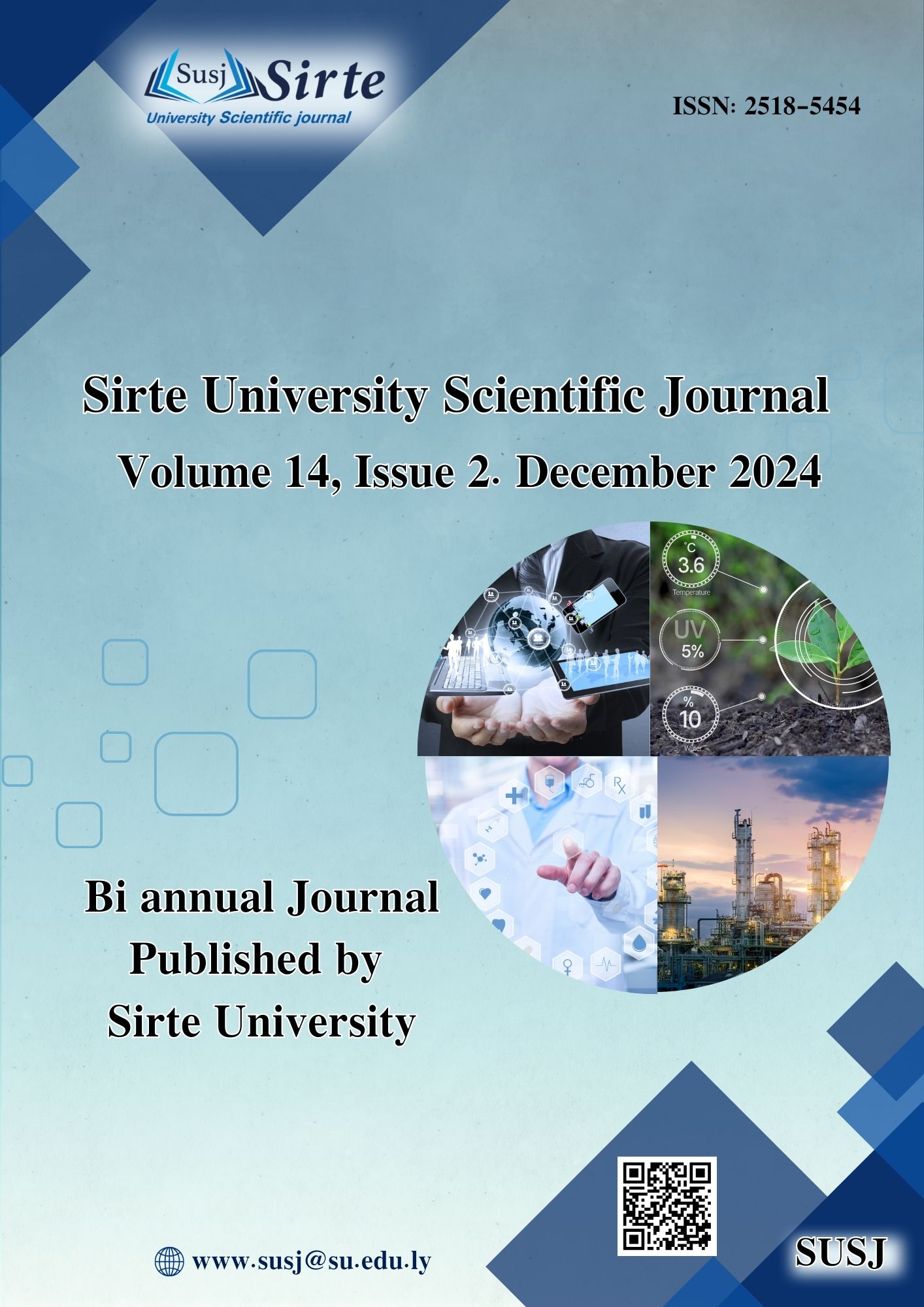Constructing the Fractional Flow Curve for the Masrab Oilfield Using Production Data: A Case Study in Libya
DOI:
https://doi.org/10.37375/susj.v14i2.3088الكلمات المفتاحية:
Masrab oilfield، Fractional flow curves، Oil-wet reservoir، Production data methodالملخص
This study focuses on evaluating the flow performance of oil and water in the Masrab oilfield, Libya, using production data. The main goal is to apply the production data method to calculate fractional flow curves, which are essential for optimizing production strategies in mature oilfield. The analysis was conducted using Excel software, which facilitated efficient calculations and plotting of the fractional flow curves. The results reveal that the field is oil-wet, a condition that has a direct impact on oil recovery efficiency. Oil wet reservoirs tend to have lower recovery rates, as water does not easily displace oil from the rock surfaces, leading to challenges in maximizing oil extraction. The production data method used in this study proved to be more accurate and practical for field applications compared to traditional methods like the Buckley-Leverett approach. Furthermore, this approach was shown to be more cost-effective and time-efficient, particularly in environments where core sampling or extensive fluid property data is difficult to obtain. The study highlights the importance of using real-time production data to assess reservoir performance, especially in challenging conditions where conventional methods may not be feasible. Based on the results, it is recommended that the production data approach be preferred in oil-wet reservoirs like Masrab, as it offers significant advantages in terms of improving oil recovery and optimizing field operations. This approach provides a more practical and accessible solution for enhancing reservoir management and increasing long-term production efficiency.
المراجع
Abbas, M., Olafuyi, O., & Giegbefumwen, P. (2015). Analytical study of viscosity effects on waterflooding performance to predict oil recovery in a linear system. Journal of Petroleum & Environmental Biotechnology.
Addami, S., & Elhaddad, E. (2024). Fractional flow curve construction using Buckley-Leverett method: A case study of the Masrab oilfield in Libya. Scientific International Conference in Science & Engineering.
Adeniyi, O. D., Nwalorb, J. U., & Akob, C. T. (2008, March). A review on waterflooding problems in Nigeria's crude. Journal of Dispersion Science and Technology. https://doi.org/10.1080/01932690701716101
Adesina, A. S., & Olugbenga, F. (2014). A new analytical model for developing fractional flow curve using production data.
Aghahoseini, R., Jahanshahi, E., & Ghaffarkhah, A. (2023). A comparative study of Buckley-Leverett and production data analysis for mature oil fields. Journal of Petroleum Science and Engineering, 216, 110805. https://doi.org/10.1016/j.peteng.2023.01.005
Al-Jasmi, A., Nasr, H., Carvajal, G. A., Cullick, A. S., Vanish, D., Wang, F., Velasquez, G., Villamizar, M., Md-Adnan, F., Betancourt, D., & Urrutia, K. (2013, March). Enabling numerical simulation and real-time production data to monitor water-flooding indicators. SPE Digital Energy Conference, The Woodlands, Texas, USA. https://doi.org/10.2118/163811-MS
Anderson, W. (1986). Wettability literature survey—Part 2: Wettability measurement. Journal of Petroleum Technology,39(11),1246-1262. https://doi.org/10.2118/13933-PA
Buckley, S. E., & Leverett, M. C. (1942). Mechanism of fluid displacement in sand. Transactions of the AIME, 146, 116-116.
Fadairo, A., Adesina, F., Adeyemi, A., & Falode, O. (2014, December). A new analytical model for developing fractional flow curve using production data. Journal of Chemical and Petroleum Engineering, 48(2), 81-90.
Ghaffarkhah, A., & Ebrahim, A. (2023). Enhancing oil recovery through real-time monitoring of water breakthrough using production data. Journal of Petroleum Exploration and Production Technology, 11(1), 117-128.
Karami, M., Khaksar Manshad, A., & Ashoori, S. (2014). The prediction of water breakthrough time and critical rate with a new equation for an Iranian oil field. Petroleum Science and Technology, 32, 211–216. https://doi.org/10.1080/10916466.2011.586960
Kida, M., Ngulde, A. B., & Sarkinbaka, Z. M. (2023). Waterflood optimization: Review on gradient-ensemble-based optimizers and data-driven proxies. Journal of Engineering Science and Technology Review, 16(4), 1-12.
Marvin, M. (2023). Application of fractional flow principles to optimize water-oil displacement and predict water breakthrough in oilfields. Journal of Petroleum Engineering, 75(2), 58-70. https://doi.org/10.1016/j.peteng.2023.02.008
Masrab Oil Field (Libya). (n.d.). Retrieved from [https://www.gem.wiki/Masrab_Oil_Field_(Libya)](https://www.gem.wiki/Masrab_Oil_Field_(Libya))
Morrow, N. R. (1990). Wettability and its effect on oil recovery. Journal of Petroleum Technology, 42(12), 1476-1484.
Yang, Z. (2009). Analysis of production decline in waterflood reservoirs. SPE Paper No. 123456. Prepared for presentation at the 2009 SPE Annual Technical Conference and Exhibition, New Orleans, Louisiana, USA.





